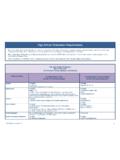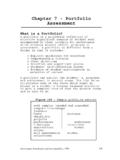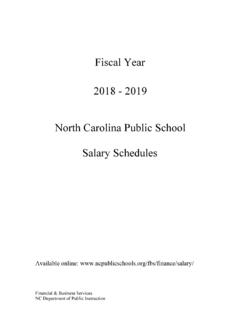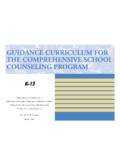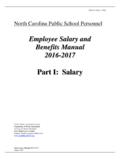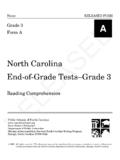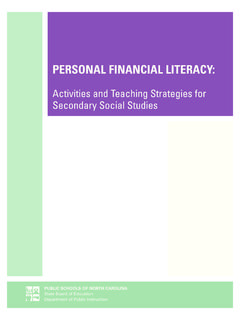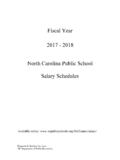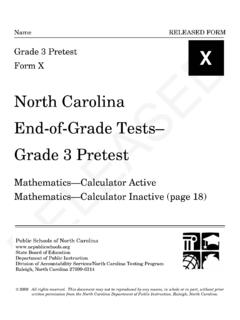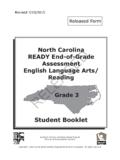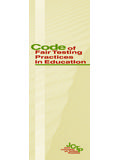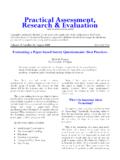Transcription of BEST PRACTICES: A Resource for Teachers
1 best practices : A Resource for Teachers Utilizing best practices in my classroom positively impacts students by providing motivation to learn and promoting success in a global world. (NC Teacher, 2006) Public Schools of North Carolina Department of Public Instruction: Elementary Division Why Are best practices Important? Thomas L. Friedman, author of The World Is Flat, refers to a twenty-first century world that will be very different from the one in which we were educated. To survive in a new, globally competitive world, today's children will need creativity, problem-solving abilities, a passion for learning, a dedicated work ethic and lifelong learning opportunities.
2 Students can develop these abilities through instruction based on best Practice teaching strategies. What Are best practices ? best practices are an inherent part of a curriculum that exemplifies the connection and relevance identified in educational research. They interject rigor into the curriculum by developing thinking and problem-solving skills through integration and active learning. Relationships are built through opportunities for communication and teamwork. best practices are applicable to all grade levels and provide the building blocks for instruction. best practices motivate, engage and prompt students to learn and achieve. Students who receive a balanced curriculum and possess the knowledge, skills and abilities to transfer and connect ideas and concepts across disciplines will be successful as measured by standardized tests and other indicators of student success.
3 Four best practices for Teachers include teaching a balanced curriculum, teaching an integrated curriculum, differentiating instruction to meet individual student needs and providing active learning opportunities for students to internalize learning. What Do best practices Look Like? Classrooms that exemplify best practices are easy to detect as soon as you enter the room. Project materials and books are numerous. Students are engaged and focused on their work. Teachers often use collaborative and/or authentic tasks that place students at the center of the learning process. Seating arrangements are clustered, varied and functional with multi- instructional areas. Classrooms are activity-based spaces as opposed to places to sit and get lectures. Teachers are actively engaged with different groups and students are anxious to enlist visitors in their various tasks or assignments.
4 There is a joyful feeling of purposeful movement, industrious thinking and a vital and vibrant atmosphere and environment. What Core best practices Can Teachers Implement in Their Classrooms? Balance the Curriculum What Is a Balanced Curriculum? What a Balanced Curriculum Is What a Balanced Curriculum Is Not Includes entire Standard Course of Study (SCS) Educates the whole child (BEP) Includes a challenging and common curriculum (CCSSO) Based on best knowledge of how children develop and learn (NASBE) Prepares students for success in school and in life (NCLB/NCDPI) Includes all subjects verses only those subjects tested (NCLRC) Promotes brain growth and development through an enriched environment (Diamond & Hopson) Provides a curriculum that Is rigorous, relevant and promotes relationships (NCSBE) Creates active participants rather than passive observers (Diamond & Hopson) Allows students to use the whole brain (Zull)
5 Planning and teaching in isolation An individual effort Teaching to the test Teaching ONLY English Language Arts and Mathematics One size fits all Teaching without assessing student needs Teaching 15-minute classes to hundreds of students Teaching the text Teaching the teacher s favorite or most comfortable topic(s) Teaching some disciplines sporadically (seasons or holidays) Fake integration A program Only for some children Why Teach a Balanced Curriculum? Standard Course of Study (As Required by NCGA/SBE) Fundamentally complete program of education ( BEP) Globalization - 21st Century Skills Superior and competitive education Beyond Sound and Basic (Governor s Ed. First Task Force) Life skills (CCSSO) Connections (Jensen) Brain development (Diamond & Hopson) Multiple intelligences (Gardner) Meets the needs of all children The 3 R s - rigor, relevance and relationships (NCSBE) Implementing a Balanced Curriculum Helps Students: Find relevance in and connections with what they are learning; Develop a love of learning and become lifelong learners; Understand themselves and those around them; Demonstrate talents they bring with them to school and Develop new, necessary skills and abilities to be successful in school and in life.
6 Integrate the Curriculum What Is an Integrated Curriculum? The practice of integrating curriculum involves students in the unit development process. It affords them the opportunity to identify topics, develop questions, plan inquiry, divide tasks, research information and share the learning process and content. Technology resources are also embedded into daily practices of the classroom. Why Teach an Integrated Curriculum? Allows Teachers time to teach their NSSCS objectives. Empowers students to take ownership of their learning. Supports brain-based research and Focuses on both ideas and content. Implementing Integration Strategies Helps Students: See the connectivity and interaction among disciplines; Choose appropriate activities; Examine organizational patterns; Develop research skills; Attack multi-levels of activity and challenge; Assume authentic responsibility; Engage in active learning; Work collaboratively with others and Refine their technology skills.
7 Differentiate the Curriculum What Is a Differentiated Curriculum? A differentiated curriculum is one where Teachers adapt the curriculum in different ways to meet the needs of all their students. The content taught, the process used, the product expected, or the physical factors of the environment created may be modified to help students achieve success. Task choices and flexible grouping may be used to accommodate background knowledge and interests of small groups or individual students. Why Differentiate Curriculum in the Classroom? Provides access to opportunities for a rigorous curriculum based on the NCSCS. Provides opportunities for individual acceleration and remediation. Nurtures self-esteem and respect. Increases motivation through exploring individual interests and Builds relationships with students by knowing their strengths.
8 Differentiating Curriculum Helps Students: Master core concepts of the curriculum; Utilize their strengths, learning styles, and background knowledge; Set individual learning goals and Develop their personal skills and projects. Provide Active Learning Opportunities What Is Active Learning? Active learning is a process in which the students are engaged in hands-on activities rather than passively receiving knowledge. Students interact with others to construct meaning from new ideas and concepts based on their background knowledge. Active learning is fast-paced, fun and personally engaging because students have the opportunity to try things out, use their senses, ask questions and discuss with others. Assignments are designed to draw upon the skills and knowledge that students have or must acquire. Cooperative learning, problem solving, and project- based learning are active learning strategies.
9 Why Utilize Active Learning in the Classroom? Draws upon the pre-existing knowledge that students already have. Is essential for idea manipulation. Enhances understanding through cooperative learning and Augments learning through technology tools. Implementing Active Learning Strategies Helps Students: Engage in higher-order thinking tasks as analysis, synthesis and evaluation; Study ideas, solve problems and apply what they have learned; Construct hypotheses and make decisions; Provide meaning and organization to experiences; Work collaboratively with others; Connect real-life work between school and what will take place in the rest of their lives and Address cultural influences and individual learning styles. Resources Daniels, H., & Bizar, M. (1998). Methods that Matter: Six Structures for best Practice Classrooms. York, ME: Stenhouse. Friedman, T., (2005). The World Is Flat.
10 New York: Farrar, Straus and Giroux. Jacobs, H. editor, (2004). Getting Results with Curriculum Mapping. Alexandria, VA: ASCD. Public Schools of North Carolina (2003). The Balanced Curriculum: A Guiding Document for Scheduling and Implementation of the NC Standard Course of Study at the Elementary Level.. Silberman, M. (1996). Active Learning: 101 Strategies to teach any Subject. Des Moines, IA: Prentice-Hall. Tomlinson, C. (2003). Differentiation in Practice: A Resource Guide for Differentiating Curriculum. Alexandria, VA: ASCD. Zemelman, S., Daniels, H., & Hyde, A. (1998). best Practice: New Standards for Teaching and Learning in America's Schools 2nd Edition. Portsmouth, NH: Heinemann.
